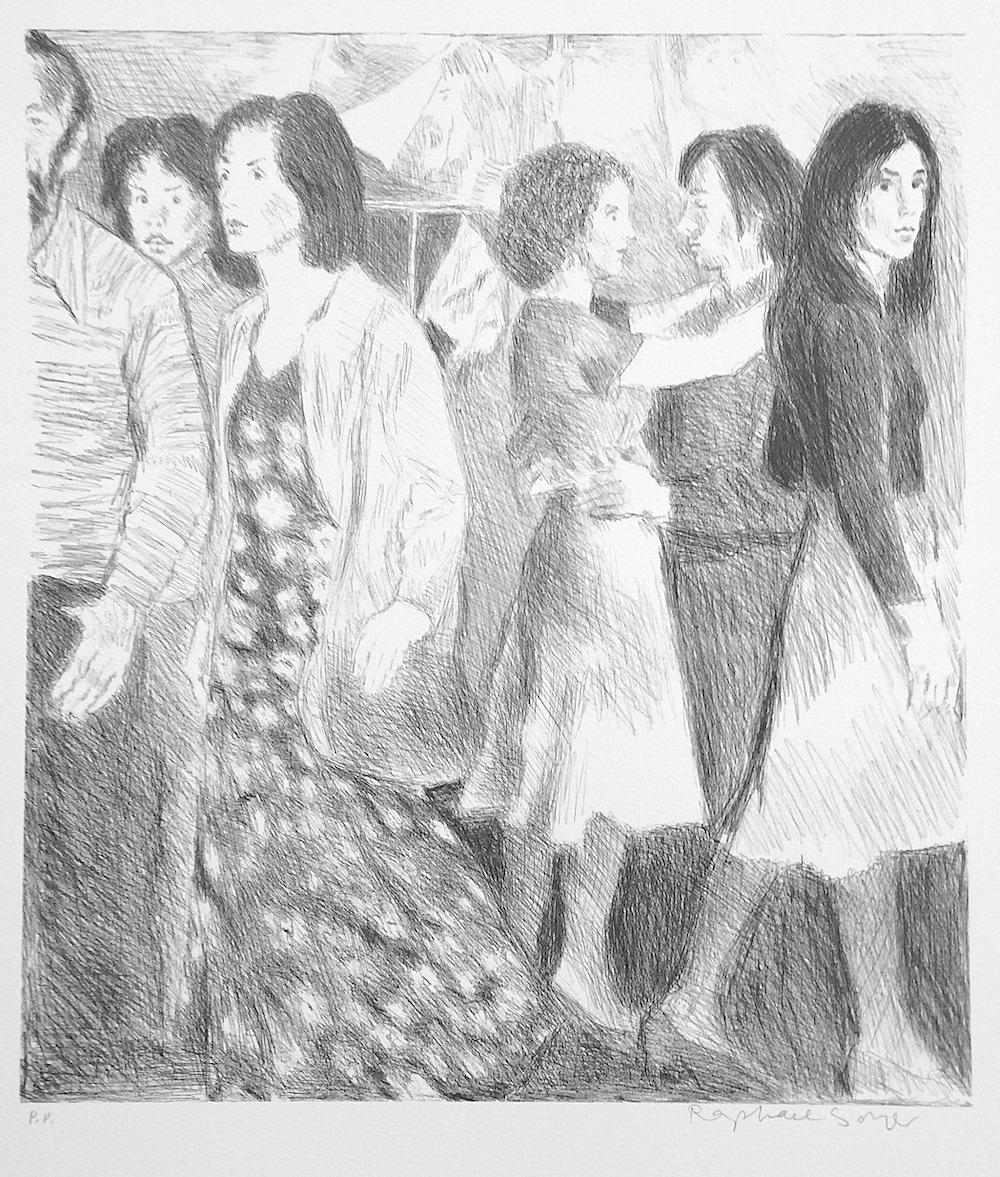Rudolph Carl Gorman„Waiting Women“1976
1976
Angaben zum Objekt
- Schöpfer*in:Rudolph Carl Gorman (1931 - 2005, Amerikanisch)
- Entstehungsjahr:1976
- Maße:Höhe: 57,79 cm (22,75 in)Breite: 77,09 cm (30,35 in)Tiefe: 2,54 cm (1 in)
- Medium:
- Bewegung und Stil:
- Zeitalter:
- Zustand:Custom framed in a clear acrylic box. Der Spiegel ist in ausgezeichnetem Zustand. The acrylic box is in good condition with a few very faint scratches.
- Galeriestandort:San Francisco, CA
- Referenznummer:
Rudolph Carl Gorman
Rudolph Carl Gorman war ein amerikanischer Künstler, der am 26. Juli 1931 in Canyon de Chelly, Arizona, geboren wurde. Er wuchs in einem traditionellen Hogan im Navajo-Reservat auf. Er wurde zu einem der bekanntesten und gefeiertsten indianischen Künstler im Südwesten der USA. Sein Markenzeichen sind Navajo-Frauen in verschiedenen Posen. Die New York Times bezeichnete ihn als den Picasso der indianischen Künstler. Seine Gemälde zeigen vor allem indianische Frauen und zeichnen sich durch fließende Formen und leuchtende Farben aus, obwohl er auch als Bildhauer, Keramiker und Steinlithograf tätig war. 1973 nahm das Metropolitan Museum of Art mehrere Werke Rudolphs in eine Ausstellung über die Kunst der amerikanischen Ureinwohner auf, und 1986 ehrte ihn die Harvard University für seine bemerkenswerten Beiträge zur amerikanischen Kunst und zur Kultur der Ureinwohner. Zu seinen Bewunderern gehörte Andy Warhol, der ihn mehrfach malte und zu den vielen Prominenten gehörte, die seine Kunst sammelten. Er war auch der Autor einer Reihe von populären Kochbüchern. Gorman starb am 3. November 2005 in Albuquerque, New Mexico.
- VersandAngebot wird abgerufen …Versand von: San Francisco, CA
- RückgabebedingungenDie Rückgabe dieses Objekts kann innerhalb von 7 Tagen ab Lieferung veranlasst werden.
- La RosaVon Rudolph Carl GormanDieses Kunstwerk mit dem Titel "La Rosa" 1984 ist eine originale Farblithographie auf Velinpapier des bekannten Navajo-Künstlers Rudolph Carl Gorman, 1932-2005. Es ist vom Künstler...Kategorie
Ende des 20. Jahrhunderts, Realismus, Figurative Drucke
MaterialienLithografie
- Navajo-Frauen, Bundesstaat #2Von Rudolph Carl GormanDieses Kunstwerk "Two Native American Women" 1980 ist eine Originallithographie auf cremefarbenem Arches-Papier des bekannten Navajo-Künstlers Rudolph Carl Gorman, 1932-2005. Es ist...Kategorie
Ende des 20. Jahrhunderts, Realismus, Figurative Drucke
MaterialienLithografie
- Naomi, NaomiVon Rudolph Carl GormanDieses Kunstwerk mit dem Titel "Naomi" 1980 ist eine Originallithographie auf cremefarbenem Arches-Papier des bekannten Navajo-Künstlers Rudolph Carl Gorman, 1932-2005. Es ist vom Kü...Kategorie
Ende des 20. Jahrhunderts, Realismus, Figurative Drucke
MaterialienLithografie
- George Inn, DorchesterDieses Kunstwerk mit dem Titel "George Inn, Dorchester" ist eine Chromolithografie des bekannten britischen Künstlers Cecil Charles Windsor Aldin (1870-1935). Es ist in der linken un...Kategorie
Mitte des 20. Jahrhunderts, Realismus, Figurative Drucke
MaterialienLithografie
- George Inn, SalisburyDieses Kunstwerk mit dem Titel "George Inn, Salisbury" ist eine Chromolithografie des bekannten britischen Künstlers Cecil Charles Windsor Aldin (1870-1935). Es ist in der linken unt...Kategorie
Mitte des 20. Jahrhunderts, Realismus, Figurative Drucke
MaterialienLithografie
- George Inn, Norton St. PhilipDieses Kunstwerk mit dem Titel "George Inn, Norton St. Philipr" ist eine Chromolithografie des bekannten britischen Künstlers Cecil Charles Windsor Aldin (1870-1935). Es ist in der l...Kategorie
Mitte des 20. Jahrhunderts, Realismus, Figurative Drucke
MaterialienLithografie
- STREET SCENE Signierte Lithographie, NYC Crowd Porträt-Bleistiftzeichnung, A-Linien-RocksVon Raphael SoyerSTREET SCENE, NYC Crowd ist eine originale, handgezeichnete Lithografie von Raphael Soyer, dem berühmten, in Russland geborenen amerikanischen realistischen Maler, Zeichner und Grafi...Kategorie
1970er, Realismus, Figurative Drucke
MaterialienLithografie
- STREET SCENE Signierte Lithographie, NYC Crowd Portrait Bleistiftzeichnung, A-Linien-RockVon Raphael SoyerSTREET SCENE, NYC Crowd ist eine originale, handgezeichnete Lithografie von Raphael Soyer, dem berühmten, in Russland geborenen amerikanischen realistischen Maler, Zeichner und Grafiker. Gedruckt mit traditionellen lithografischen Drucktechniken auf Arches-Papier, 100% säurefreies Papier, signiert und nummeriert mit Bleistift. Eine einfühlsame, realistische Straßenszene in New York mit einer Gruppe junger Leute, eine Frau trägt einen hellolivfarbenen Strickpullover, ein Kleid mit Rosenmuster...Kategorie
1970er, Realismus, Figurative Drucke
MaterialienLithografie
- Le Vieux Manuscrits, Coree-SeoulVon Paul JacouletFaszinierendes Kunstwerk mit dem Titel Le Vieux manusrits (alte Schriften Seoul Korea) von Paul Jacoulet. (französisch-japanisch 1896-1960), fein gearbeitet mit schönem Farbverlauf v...Kategorie
20. Jahrhundert, Realismus, Figurative Drucke
MaterialienHolzschnitt
- Diptychon 1980. Papier, Linolschnitt, jedes Kunstwerk 24,5х15 cmVon Nikolai UvarovDiptychon 1980. Papier, Linolschnitt, jedes Kunstwerk 24,5х15 cm Das Diptychon aus dem Jahr 1980 besteht aus zwei Linolschnitten auf Papier. Jedes Kunstwerk ist 24,5x15 cm groß. Da...Kategorie
1980er, Realismus, Figurative Drucke
MaterialienPapier, Linolschnitt
- Gerahmtes Paar architektonischer Stiche, nach Giocondo Albertolli angefertigtGerahmtes Paar architektonischer Stiche, die nach Giocondo Albertolli in Italien während der neoklassischen Periode des 18. Jahrhunderts entstanden. Dieses Paar von Gravuren messen ...Kategorie
18. Jahrhundert, Realismus, Figurative Drucke
MaterialienPapier, Gravur
- Couchtisch von Pompiers- Pompiers De Paris, Armee de Ligne Lithographie von Lemercier, 1861Von Édouard Armand-DumaresqSapeurs- Pompiers De Paris, Officier et Soldat ( Grandes Tenures).... Feuerwehr in Paris, Offizier und Soldat (Großes Tenure ) zeigt zwei Schnauzbartträger Französische Soldaten...Kategorie
1860er, Figurative Drucke
MaterialienLithografie

